Enhancing the Strength and the Environmental Performance of Concrete with Pre-Treated Crumb Rubber and Micro-Silica
Abstract
:1. Introduction
2. Results and Discussion
2.1. Results for Trial Mixes at M20 and M30 Grade
2.2. Workability
2.3. Mechanical Strength of Crumb Rubber Concrete
2.3.1. Compressive Strength
2.3.2. Tensile Strength
2.4. Mechanical Performance Results Analysis
2.4.1. Predictive Compressive Strength of M20 Grade Concrete
2.4.2. Predictive Compressive Strength of M30 Grade Concrete
2.5. Microstructural Analysis
2.5.1. Scanning Electron Microscopy (SEM) Analysis
2.5.2. Energy Dispersive X-ray Spectroscopy (EDS)
2.5.3. X-ray Diffraction (XRD)
2.6. Life Cycle Assessment
3. Materials and Methods
3.1. Cement
3.2. Fine Aggregate
3.3. Coarse Aggregate
3.4. Water
3.5. Crumb Rubber
3.6. NaOH Crystals
3.7. Powdered Micro-Silica
3.8. Replacement Ratio Selection and Notations
3.9. Concrete Mix Design
3.10. Crumb Rubber Concrete Mechanical Performance Predictive Models
3.10.1. Predictive Model 1
3.10.2. Predictive Model 2
3.10.3. Predictive Model 3
3.11. Microstructural Characterization
3.11.1. Scanning Electron Microscopy (SEM)
3.11.2. Energy Dispersive X-ray Spectroscopy
3.11.3. X-ray Diffraction (XRD)
3.12. Life Cycle Assessment
4. Conclusions
- Substituting 5% crumb rubber for M20 and M30 grade concrete and adding micro-silica resulted in the highest compressive and split tensile strengths. Conversely, when 20% crumb rubber replaced untreated concrete, the lowest strengths were observed.
- A 5 M aqueous solution of NaOH was found to be optimal for the pre-treatment of CRC.
- A reduction in the slump was observed in CRC samples that underwent NaOH pre-treatment and micro-silica addition; however, the values stayed within the acceptable range, as per IS 456 provisions.
- The predictive models, focusing on crumb rubber’s volumetric replacement in concrete, overlooked treatment methods. Including these methods and admixture types could refine the models for more accurate compressive strength predictions.
- According to SEM images, silica fume in concrete helped to fill gaps caused by rubber particle growth, reducing void volume and porosity while increasing density. This resulted in enhanced mechanical properties of the concrete.
- Lower Ca/Si ratios, as per the EDS results, signified a higher presence of the CSH gel, with low Ca/Si ratio calcium silicate hydrates showing greater stability, compared to high Ca/Si ratio ones. The treated samples M20TCR10 and M20TCR20 exhibited lower Ca/Si ratios than the untreated samples, indicating a higher percentage of CSH and correlating with the improved strength observed in the treated samples.
- According to the XRD results, different phases of the crystalline structure of CRC were observed. The highest peaks in the XRD results corresponded to the tricalcium silicate (C3S) and dicalcium silicate (C2S) phases, suggesting high strength in the concrete.
- The comparative LCA analysis between crumb rubber concrete and conventional concrete across different M20 and M30 mixes indicated that incorporating micro-silica into crumb rubber concrete did not result in a significant rise in environmental impacts. However, treating crumb rubber with sodium hydroxide solution led to a slight increase in environmental impacts.
- The feasibility and economic viability of scaling up crumb rubber concrete production for widespread adoption in the construction sector hinges on a complex array of factors. Despite challenges, the potential environmental advantages and the prospect of enhancing concrete properties may stimulate innovation and investment in this domain.
5. Scope for Future Research
- The inclusion of pre-treated crumb rubber and micro-silica in concrete mixtures has shown promise in enhanced workability and strength. Building on these results, several other innovative methods and technologies, like incorporating nano-sized particles and applying a nano-coating on crumb rubber particles, could be studied further to improve these properties.
- Using computational models to optimize the particle size distribution and packing density, involving adjusting the proportions of crumb rubber, micro-silica, and other components, could potentially improve these properties for a more viable and sustainable option.
- To explore the lifecycle environmental benefits of crumb rubber concrete in specific applications like road construction or building facades, a comparative LCA study can be designed, utilizing a tool like SimaPro for a comprehensive environmental impact assessment.
Author Contributions
Funding
Data Availability Statement
Acknowledgments
Conflicts of Interest
References
- Jokar, F.; Khorram, M.; Karimi, G.; Hataf, N. Experimental investigation of mechanical properties of crumbed rubber concrete containing natural zeolite. Constr. Build. Mater. 2019, 208, 651–658. [Google Scholar] [CrossRef]
- Wu, Y.-F.; Kazmi, S.M.S.; Munir, M.J.; Zhou, Y.; Xing, F. Effect of compression casting method on the compressive strength, elastic modulus and microstructure of rubber concrete. J. Clean. Prod. 2020, 264, 121746. [Google Scholar] [CrossRef]
- Rodríguez-Fernández, I.; Baheri, F.T.; Cavalli, M.C.; Poulikakos, L.D.; Bueno, M. Microstructure analysis and mechanical performance of crumb rubber modified asphalt concrete using the dry process. Constr. Build. Mater. 2020, 259, 119662. [Google Scholar] [CrossRef]
- Roychand, R.; Gravina, R.J.; Zhuge, Y.; Ma, X.; Mills, J.E.; Youssf, O. Practical rubber pre-treatment approch for concrete use—An experimental study. J. Compos. Sci. 2021, 5, 143. [Google Scholar] [CrossRef]
- Abdelmonem, A.; El-Feky, M.; Nasr, E.-S.A.; Kohail, M. Performance of high strength concrete containing recycled rubber. Constr. Build. Mater. 2019, 227, 116660. [Google Scholar] [CrossRef]
- Ansari, M.T.; Sakthieswaran, N.; Babu, O.G. Experimental study of an eco-friendly concrete by inbuilt with treated crumb rubber. Mater. Today Proc. 2021, 37, 1028–1031. [Google Scholar] [CrossRef]
- Gravina, R.J.; Xie, T. Toward the development of sustainable concrete with Crumb Rubber: Design-oriented Models, Life-Cycle-Assessment and a site application. Constr. Build. Mater. 2022, 315, 125565. [Google Scholar] [CrossRef]
- Rajagopal, M.R.; Bhavya, M.; Kumari, G.J. Study on the impact of pre-treatment method and admixture on the mechanical and durability prop-erties of crumb rubber concrete. AIP Conf. Proc. 2024, 3010, 020010. [Google Scholar]
- Ren, F.; Mo, J.; Wang, Q.; Ho, J.C.M. Crumb rubber as partial replacement for fine aggregate in concrete: An overview. Constr. Build. Mater. 2022, 343, 128049. [Google Scholar] [CrossRef]
- Xiao, R.; Shen, Z.; Si, R.; Polaczyk, P.; Li, Y.; Zhou, H.; Huang, B. Alkali-activated slag (AAS) and OPC-based composites containing crumb rubber aggregate: Physi-co-mechanical properties, durability and oxidation of rubber upon NaOH treatment. J. Clean. Prod. 2022, 367, 132896. [Google Scholar] [CrossRef]
- Emam, E.; Yehia, S. Experimental study on enhanced crumb rubber concrete. Int. J. Sci. Eng. Res. 2018, 9, 1240–1247. [Google Scholar]
- Adeboje, A.O.; Kupolati, W.K.; Sadiku, E.R.; Ndambuki, J.M. Characterization of modified crumb rubber concrete. Int. J. Sustain. Dev. Plan. 2020, 15, 377–383. [Google Scholar] [CrossRef]
- Li, Y.; Zhang, X.; Wang, R.; Lei, Y. Performance enhancement of rubberised concrete via surface modification of rubber: A review. Constr. Build. Mater. 2019, 227, 116691. [Google Scholar] [CrossRef]
- Najim, K.; Hall, M. Mechanical and dynamic properties of self-compacting crumb rubber modified concrete. Constr. Build. Mater. 2012, 27, 521–530. [Google Scholar] [CrossRef]
- Pelisser, F.; Zavarise, N.; Longo, T.A.; Bernardin, A.M. Concrete made with recycled tire rubber: Effect of alkaline activation and silica fume addition. J. Clean. Prod. 2011, 19, 757–763. [Google Scholar] [CrossRef]
- Rajan, R.G.; Sakthieswaran, N.; Babu, O.G. Experimental investigation of sustainable concrete by partial replacement of fine aggregate with treated waste tire rubber by acidic nature. Mater. Today Proc. 2021, 37, 1019–1022. [Google Scholar] [CrossRef]
- Pham, T.M.; Lim, Y.Y.; Malekzadeh, M. Effect of pre-treatment methods of crumb rubber on strength, permeability and acid attack resistance of rub-berized geopolymer concrete. J. Build. Eng. 2021, 41, 102448. [Google Scholar]
- Huang, W.; Huang, X.; Xing, Q.; Zhou, Z. Strength reduction factor of crumb rubber as fine aggregate replacement in concrete. J. Build. Eng. 2020, 32, 101346. [Google Scholar] [CrossRef]
- Copetti, C.M.; Borges, P.M.; Squiavon, J.Z.; da Silva, S.R.; Andrade, J.J.d.O. Evaluation of tire rubber surface pre-treatment and silica fume on physical-mechanical behavior and microstructural properties of concrete. J. Clean. Prod. 2020, 256, 120670. [Google Scholar] [CrossRef]
- Wang, J.; Guo, Z.; Yuan, Q.; Zhang, P.; Fang, H. Effects of ages on the ITZ microstructure of crumb rubber concrete. Constr. Build. Mater. 2020, 254, 119329. [Google Scholar] [CrossRef]
- Reda Taha, M.M.; El-Dieb, A.S.; Abd El-Wahab, M.A.; Abdel-Hameed, M.E. Mechanical, fracture, and microstructural investigations of rubber concrete. J. Mater. Civ. Eng. 2008, 20, 640–649. [Google Scholar] [CrossRef]
- Youssf, O.; ElGawady, M.A.; Mills, J.E.; Ma, X. Prediction of Crumb Rubber Concrete Strength. Ph.D. Thesis, University of South Australia, Adelaide, Australia, 2014. [Google Scholar]
- Assaggaf, R.A.; Ali, M.R.; Al-Dulaijan, S.U.; Maslehuddin, M. Properties of concrete with untreated and treated crumb rubber—A review. J. Mater. Res. Technol. 2021, 11, 1753–1798. [Google Scholar] [CrossRef]
- Alawais, A.; West, R.P. Ultra-violet and chemical treatment of crumb rubber aggregate in a sustainable concrete mix. J. Struct. Integr. Maint. 2019, 4, 144–152. [Google Scholar] [CrossRef]
- Onuaguluchi, O. Effects of surface pre-coating and silica fume on crumb rubber-cement matrix interface and cement mortar properties. J. Clean. Prod. 2015, 104, 339–345. [Google Scholar] [CrossRef]
- He, L.; Ma, Y.; Liu, Q.; Mu, Y. Surface modification of crumb rubber and its influence on the mechanical properties of rubber-cement concrete. Constr. Build. Mater. 2016, 120, 403–407. [Google Scholar] [CrossRef]
- Su, H.; Yang, J.; Ghataora, G.S.; Dirar, S. Surface modified used rubber tire aggregates: Effect on recycled concrete performance. Mag. Concr. Res. 2015, 67, 680–691. [Google Scholar] [CrossRef]
- Dong, Q.; Huang, B.; Shu, X. Rubber modified concrete improved by chemically active coating and silane coupling agent. Constr. Build. Mater. 2013, 48, 116–123. [Google Scholar] [CrossRef]
- Wang, J.; Dai, Q.; Si, R.; Guo, S. Mechanical, durability, and microstructural properties of macro synthetic polypropylene (PP) fi-ber-reinforced rubber concrete. J. Clean. Prod. 2019, 234, 1351–1364. [Google Scholar] [CrossRef]
- Means, P.; Guggemos, A. Framework for Life Cycle Assessment (LCA) Based Environmental Decision Making During the Conceptual Design Phase for Commercial Buildings. Procedia Eng. 2015, 118, 802–812. [Google Scholar] [CrossRef]
- Saleem, M.; Chhipi-Shrestha, G.; Túlio Barbosa Andrade, M.; Dyck, R.; Ruparathna, R.; Hewage, K.; Sadiq, R. Life Cycle Thinking–Based Selection of Building Facades. J. Archit. Eng. 2018, 24, 04018029. [Google Scholar] [CrossRef]
- IS: 12269; 53 Grade Ordinary Portland Cement. 1987. Available online: https://law.resource.org/pub/in/bis/S03/is.12269.1987.pdf (accessed on 4 January 2022).
- IS: 4031 (Part1); Method of Physical Tests for Hydraulic Cement. 1996. Available online: https://law.resource.org/pub/in/bis/S03/is.12269.1987.pdf (accessed on 4 January 2022).
- IS: 383-1970; Specification for Coarse and Fine Aggregates from Natural Sources for Concrete. Available online: https://law.resource.org/pub/in/bis/S03/is.383.1970.pdf (accessed on 4 January 2022).
- IS: 2386 (Part I); Methods of Test for Aggregates for Concrete Part I Particle Size and Shape. 1963. Available online: https://law.resource.org/pub/in/bis/S03/is.2386.1.1963.pdf (accessed on 4 January 2022).
- IS: I 2720 (Part III); Methods of Test for Soils Part III Determination of Specific Gravity. 1980. Available online: https://law.resource.org/pub/in/bis/S03/is.2720.3.1.1980.pdf (accessed on 4 January 2022).
- Jie, X.U.; Yao, Z.; Yang, G.; Han, Q. Research on crumb rubber concrete: From a multi-scale review. Constr. Build. Mater. 2020, 232, 117282. [Google Scholar]
- IS: 10262; Concrete Mix Proportioning—Guidelines. 2009. Available online: https://law.resource.org/pub/in/bis/S03/is.10262.2009.pdf (accessed on 4 January 2022).
- IS: 7320; Specification for Concrete Slump Test Apparatus. 1974. Available online: https://law.resource.org/pub/in/bis/S03/is.7320.1974.pdf (accessed on 4 January 2022).
- IS: 456; Plain and Reinforced Concrete—Code of Practice. 2000. Available online: https://law.resource.org/pub/in/bis/S03/is.456.2000.pdf (accessed on 4 January 2022).
- IS: 516-1959; Methods of Tests or Strength of Concrete. Available online: https://law.resource.org/pub/in/bis/S03/is.516.1959.pdf (accessed on 4 January 2022).
- Mehta, P.K.; Monteiro, P.J.M. Concrete: Microstructure, Properties, and Materials; McGraw-Hill Education: New York, NY, USA, 2014. [Google Scholar]
- Neville, A.M.; Brooks, J.J. Concrete Technology; Longman Scientific & Technical: London, UK, 1987; Volume 438. [Google Scholar]
- Sri Rama Chand, M.; Rathish Kumar, P.; Swamy Naga Ratna Giri, P.; Rajesh Kumar, G. Performance and microstructure characteristics of self-curing self-compacting concrete. Adv. Cem. Res. 2018, 30, 451–468. [Google Scholar] [CrossRef]
- Bellum, R.R.; Venkatesh, C.; Madduru, S.R.C. Influence of red mud on performance enhancement of fly ash-based geopolymer concrete. Innov. Infrastruct. Solut. 2021, 6, 215. [Google Scholar] [CrossRef]
- Pamu, Y.; Alugubelli, S. A comparative study of environmental impacts due to conventional and sustainable concrete. Mater. Today Proc. 2023, 92, 112–120. [Google Scholar] [CrossRef]

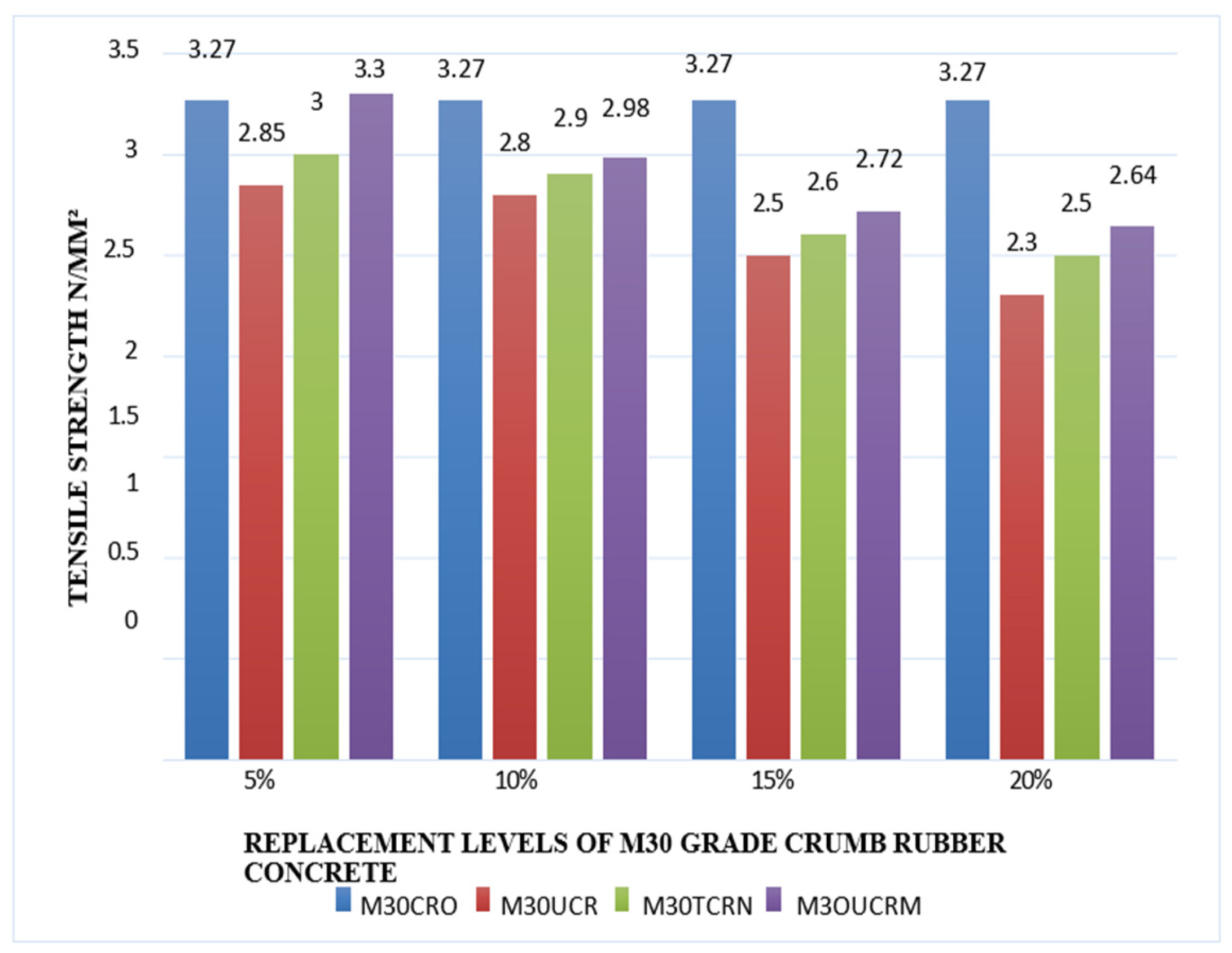
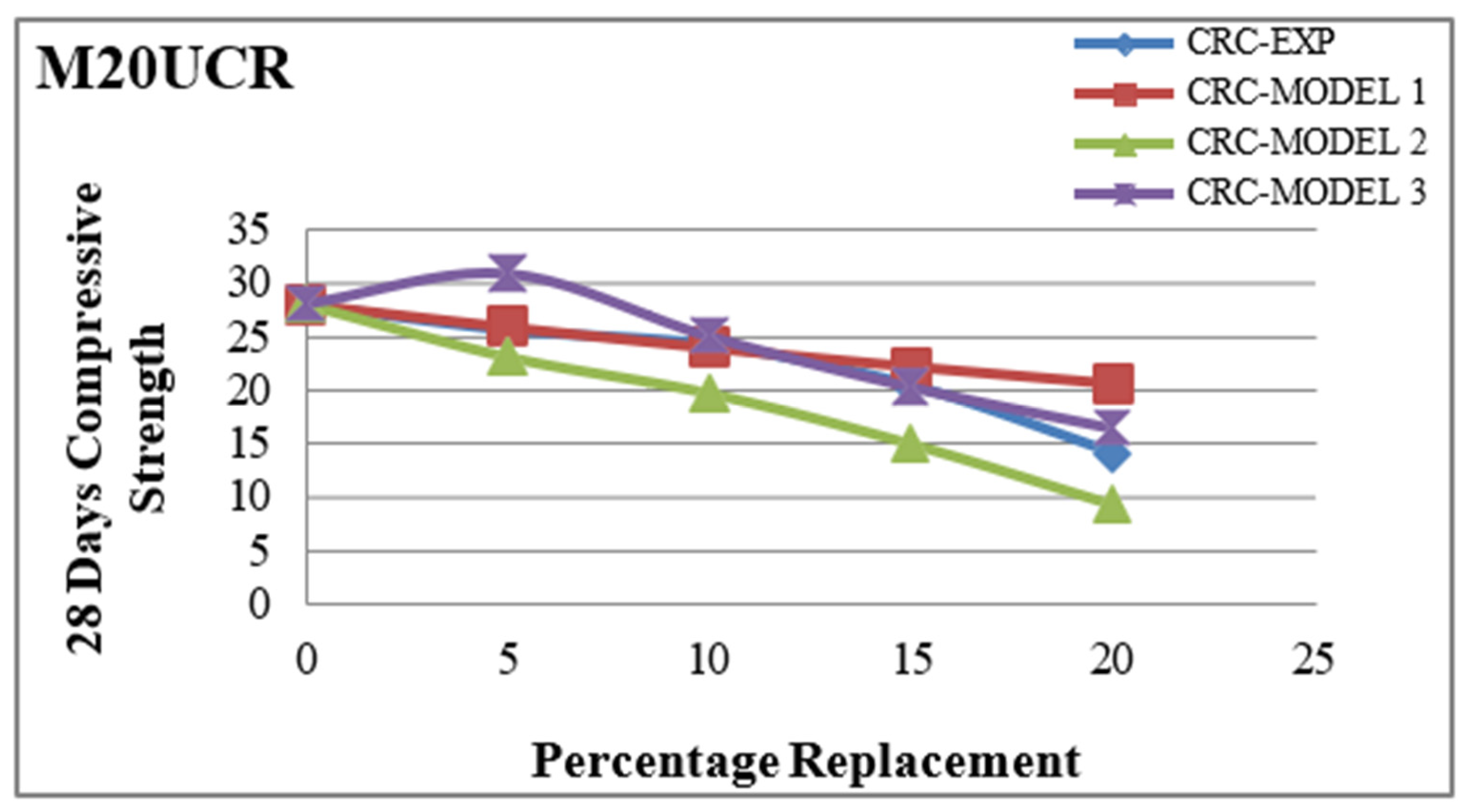

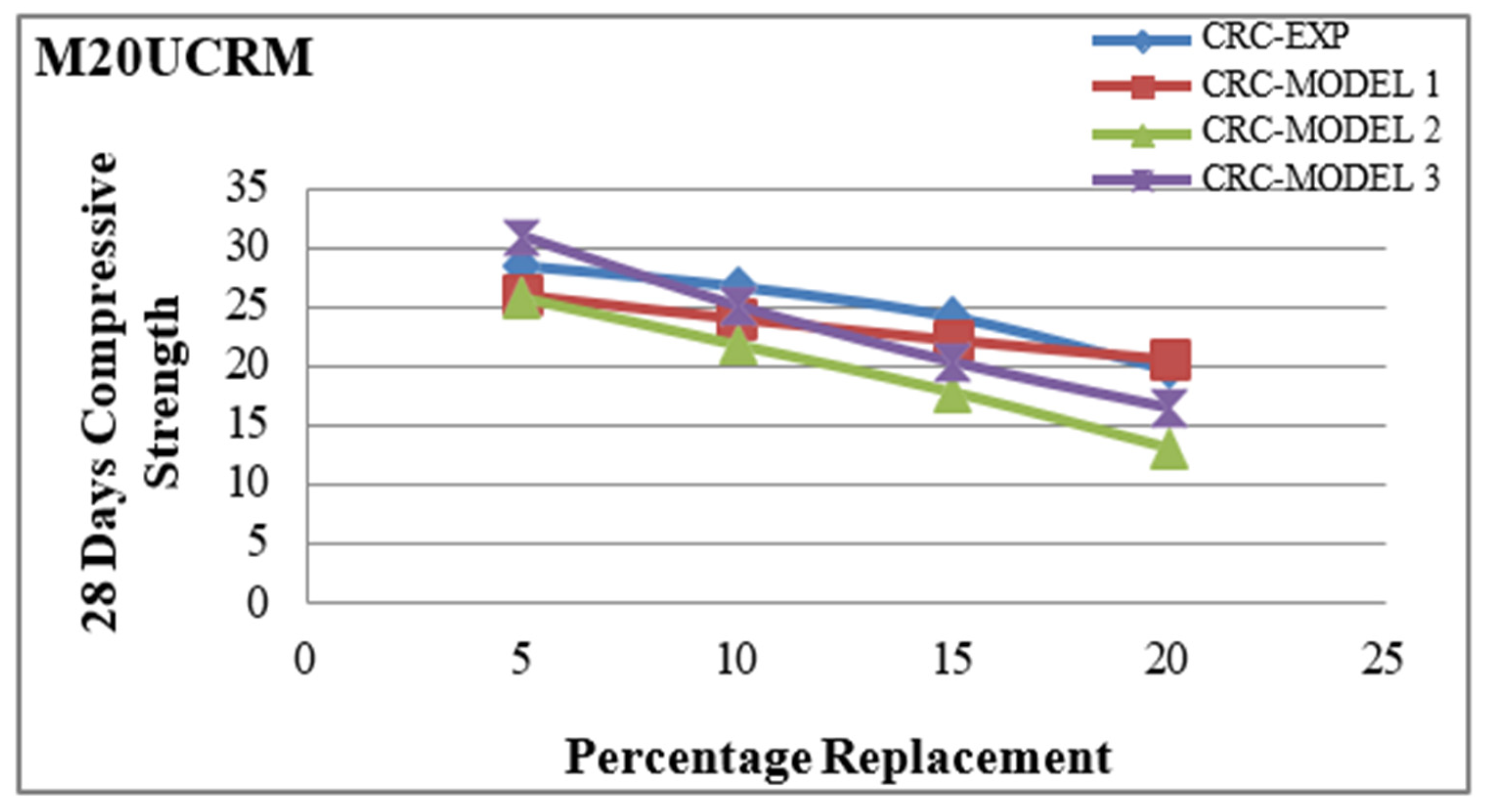
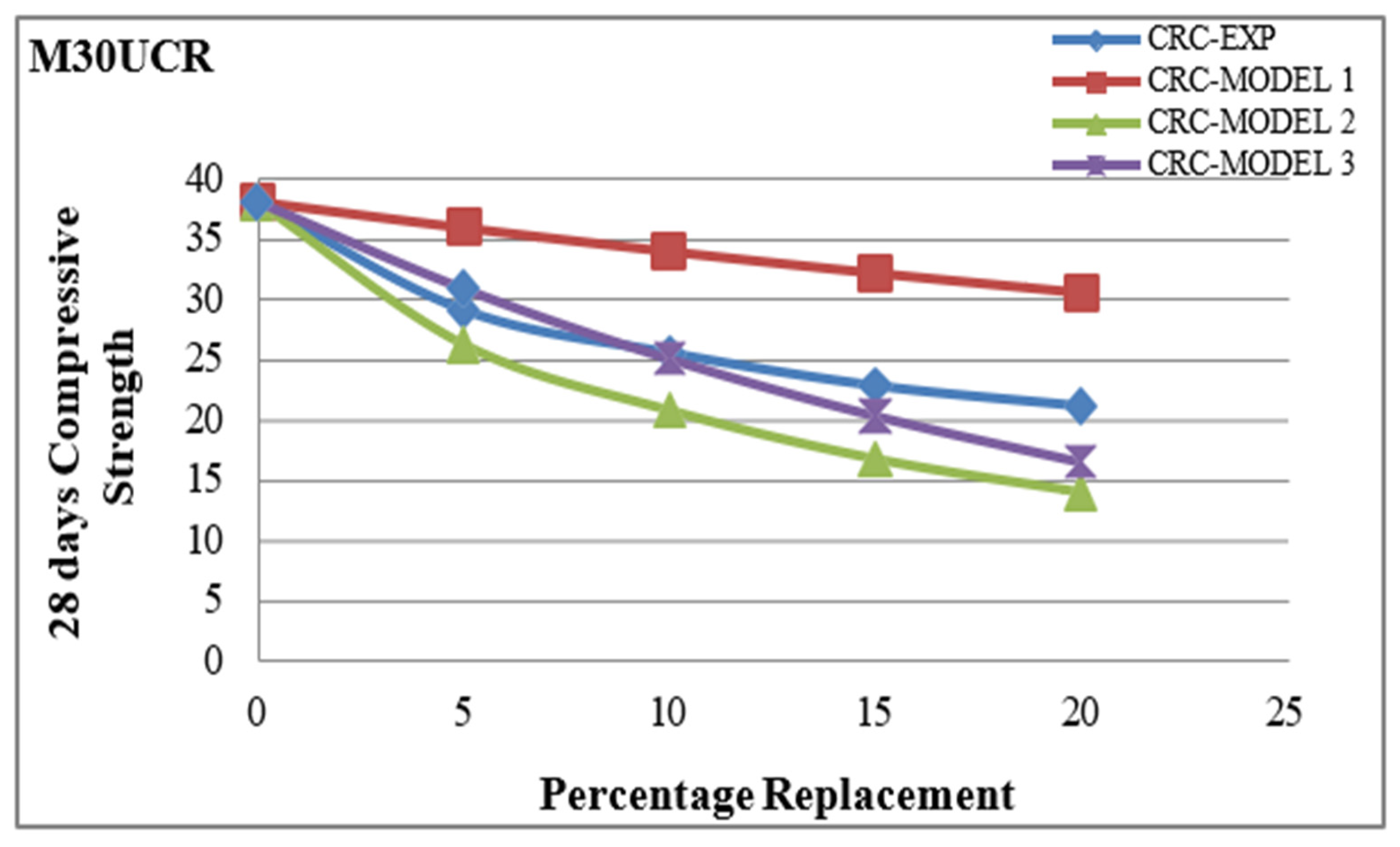
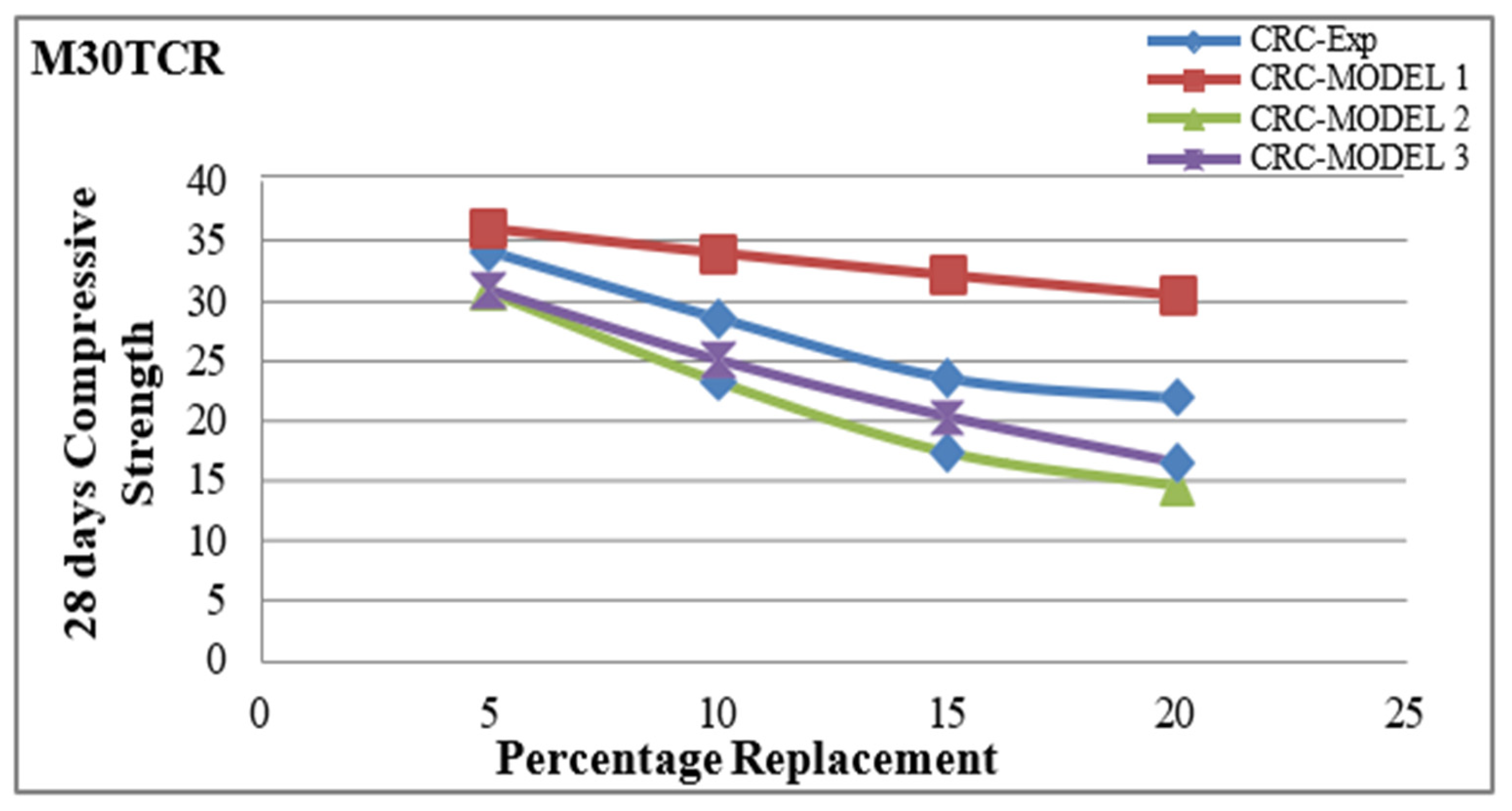
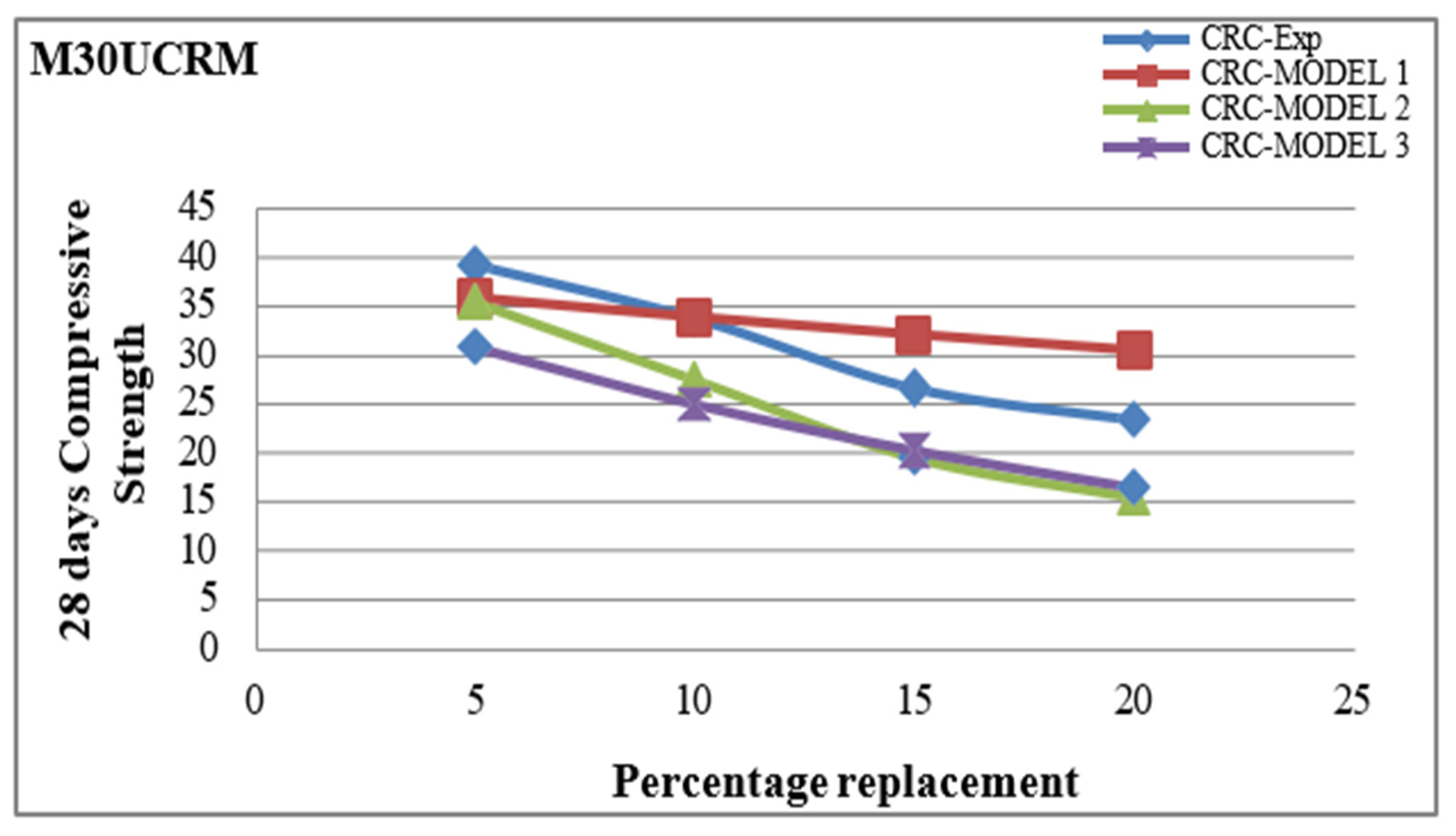
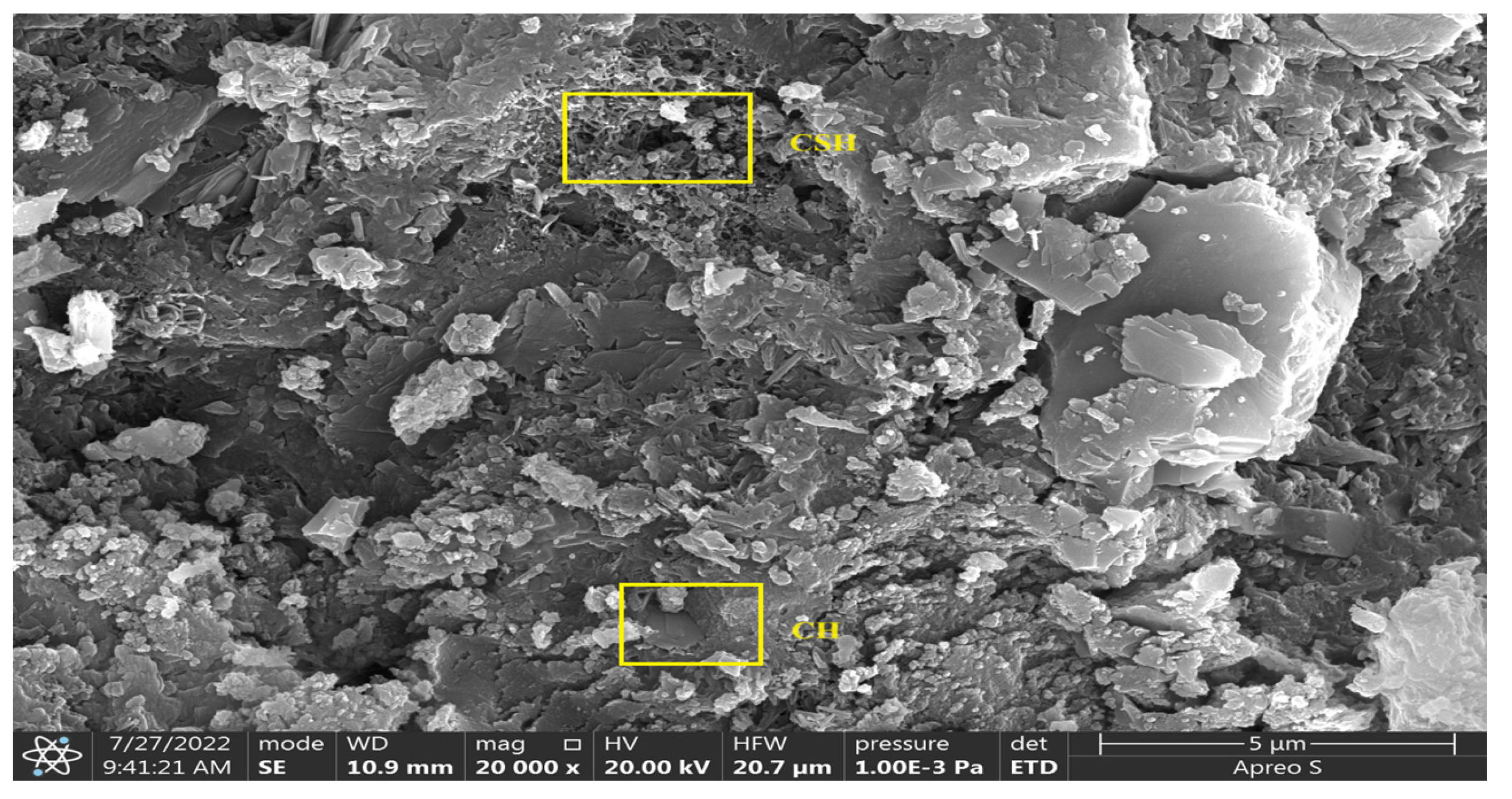
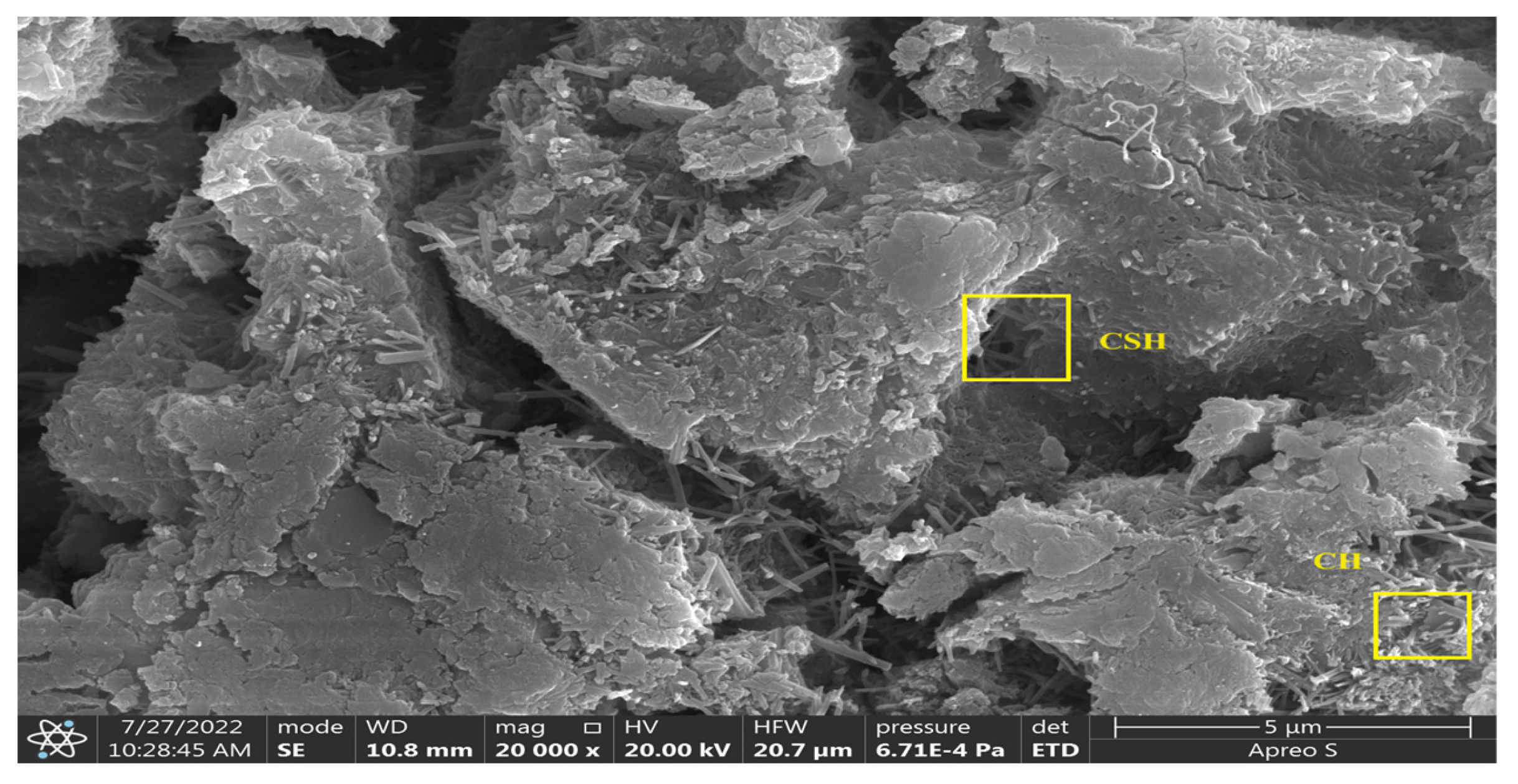



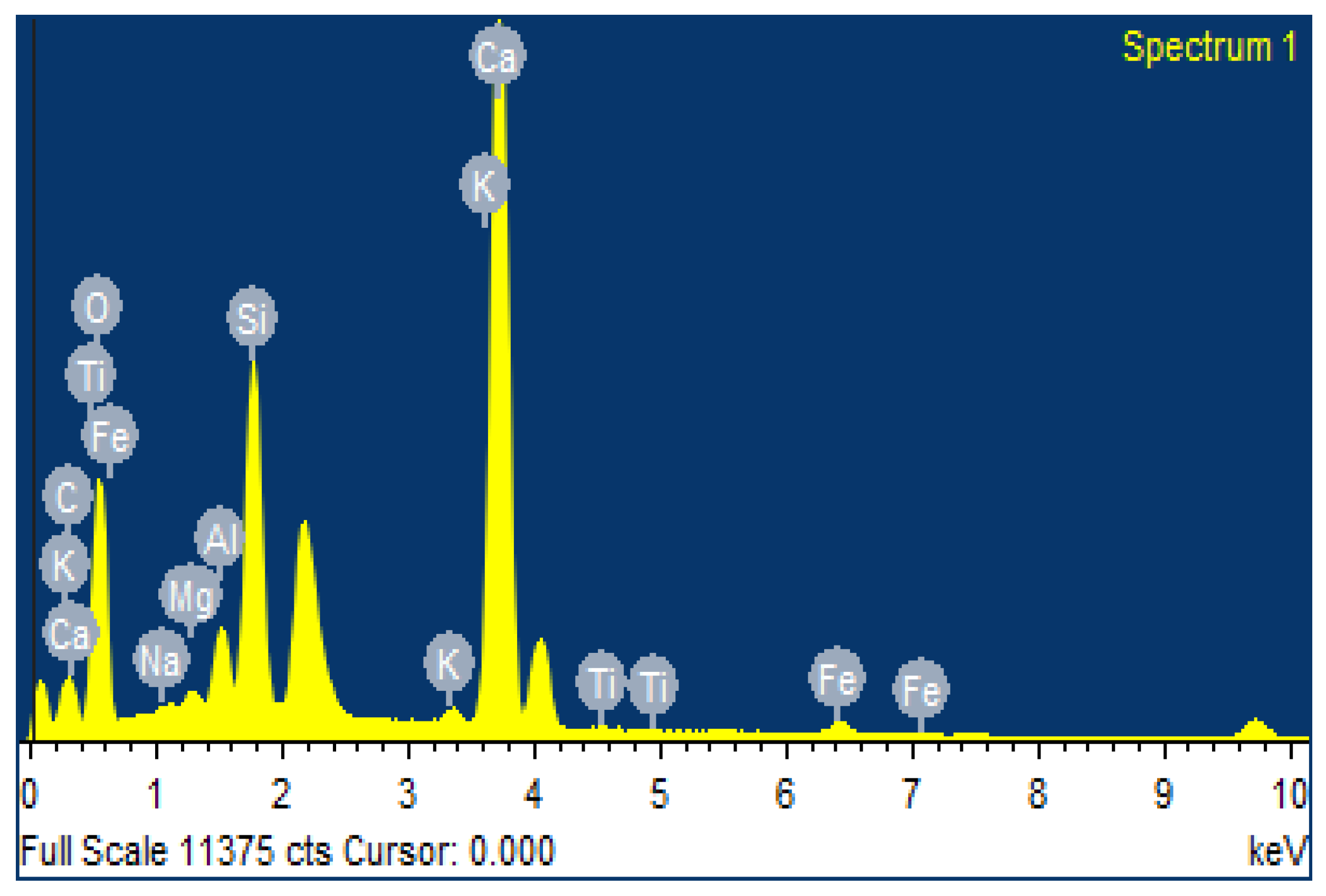
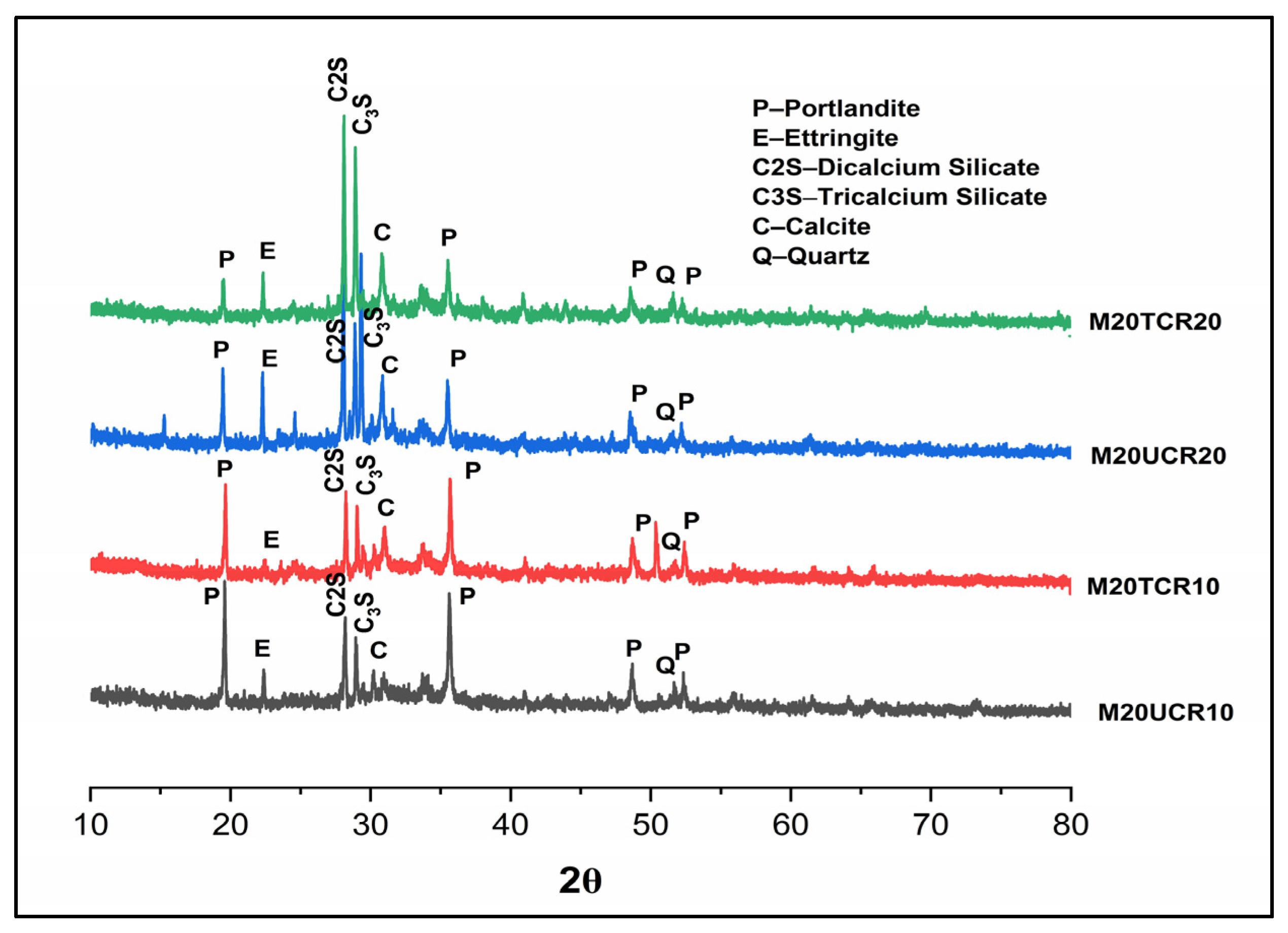

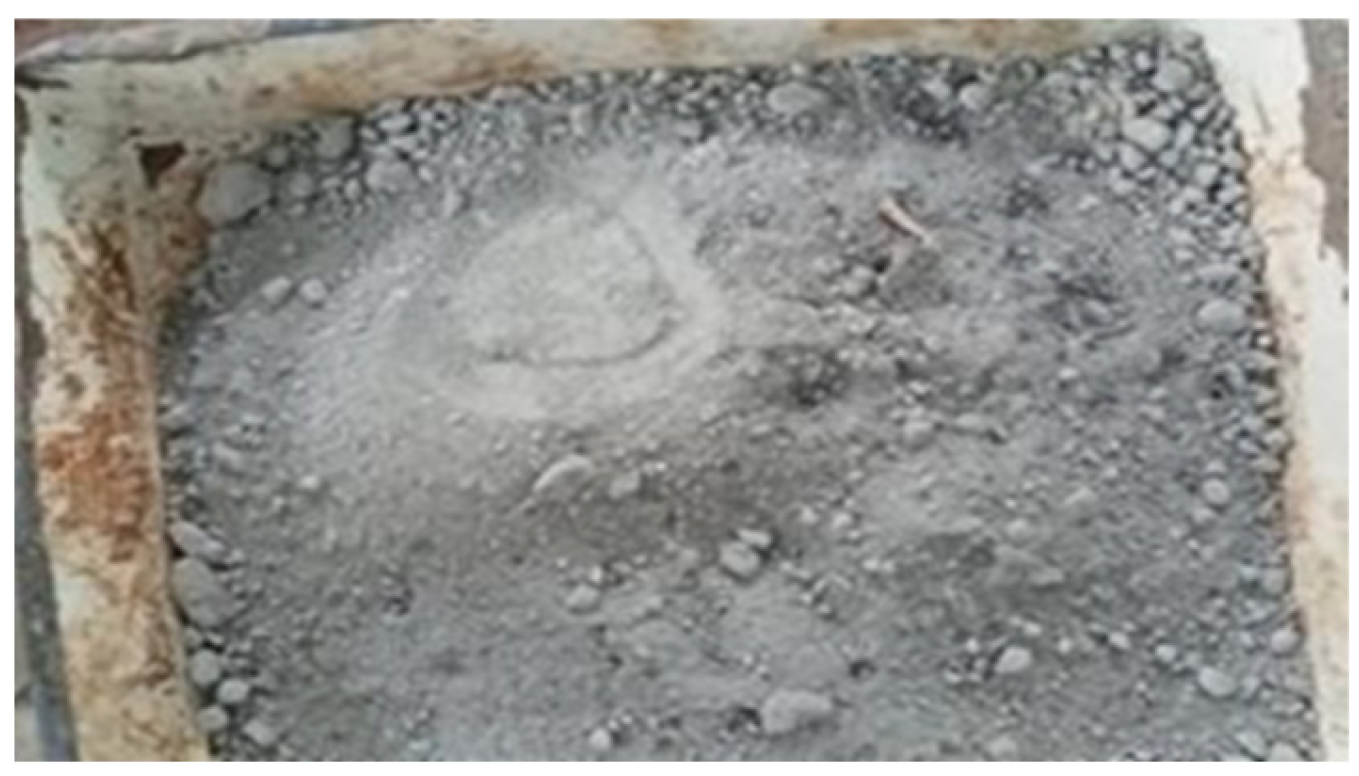
| Type of Concrete | M20CR0 | M30CR0 | M20UCR10 | M30UCR10 | M20TCR10 | M30TCR10 |
| Compressive * Strength (MPa) | 18.95 | 28.00 | 17.60 | 25.43 | 17.82 | 26.46 |
| Type of concrete | M20CR0 | M20UCR5 | M20UCR10 | M20UCR15 | M20UCR20 | M20TCRN5 | M20TCRN10 | M20TCRN15 | M20TCRN20 | M20UCRM5 | M20UCRM10 | M20UCRM15 | M20UCRM20 |
| Slump value (mm) | 72 | 90 | 98 | 106 | 120 | 65 | 79 | 86 | 90 | 62 | 70 | 92 | 95 |
| Type of concrete | M30CR0 | M30UCR5 | M30UCR10 | M30UCR15 | M30UCR20 | M30TCRN5 | M20TCRN10 | M30TCRN15 | M30TCRN20 | M30UCRM5 | M30UCRM10 | M30UCRM15 | M30UCRM20 |
| Slump value (mm) | 64 | 80 | 87 | 99 | 113 | 60 | 70 | 82 | 87 | 55 | 60 | 74 | 88 |
| Type of Specimen | Compressive Strength (Mpa) | Predictive Model l (Mpa) | Predictive Model 2 (Mpa) | Predictive Model 3 (Mpa) |
|---|---|---|---|---|
| M20CRO | 28 | 28 | 28 | 28 |
| M20UCR5 | 25.6 | 25.85 | 23.09 | 30.8 |
| M20UCR10 | 242 | 23.89 | 19.69 | 24.97 |
| M20UCR15 | 20.37 | 22.10 | 14.94 | 20.24 |
| M20UCR20 | 14 | 20.48 | 9.26 | 16.4 |
| M20TCR05 | 27.32 | 25.85 | 24.64 | 30.8 |
| M20TCR10 | 25 | 23.89 | 20.34 | 24.97 |
| M20TCR15 | 23.26 | 22.10 | 17.06 | 20.24 |
| M20TCR20 | 17.14 | 20.48 | 11.33 | 16.4 |
| M20UCRM05 | 28.4 | 25.85 | 25.62 | 30.8 |
| M20UCRM10 | 26.62 | 23.89 | 21.65 | 24.97 |
| M20UCRM15 | 24.04 | 22.10 | 17.63 | 20.24 |
| M20UCRM20 | 19.58 | 20.48 | 12.94 | 16.4 |
| Type of Specimen | Compressive Strength MPa | Predictive Model 1 (Mpa) | Predictive Model 2 (Mpa) | Predictive Model 3 (Mpa) |
|---|---|---|---|---|
| M30CR0 | 38 | 38.00 | 38 | 38 |
| M30UCR5 | 29 | 35.85 | 26.16 | 30.8 |
| M30UCR10 | 25.43 | 33.89 | 20.69 | 24.97 |
| M30UCR15 | 22.7 | 32.10 | 16.65 | 20.24 |
| M30UCR20 | 21 | 30.48 | 13.88 | 16.4 |
| M30TCR05 | 34 | 35.85 | 30.67 | 30.8 |
| M30TCR10 | 28.46 | 33.89 | 23.15 | 24.97 |
| M30TCR15 | 23.5 | 32.10 | 17.24 | 20.24 |
| M30TCR20 | 21.85 | 30.48 | 14.45 | 16.4 |
| M30UCRM05 | 39.2 | 35.85 | 35.36 | 30.8 |
| M30UCRM10 | 33.73 | 33.89 | 27.44 | 24.97 |
| M30UCRM15 | 26.58 | 32.10 | 19.49 | 20.24 |
| M30UCRM20 | 23.34 | 30.48 | 15.43 | 16.4 |
| Climate Change | Impact Category | Impact Results for Different Mixes (kg CO2-Eq) | ||||||
|---|---|---|---|---|---|---|---|---|
| M20 | M20UCR05 | M20UCR10 | M20TCR05 | M20TCR10 | M20UCRM05 | M20UCRM10 | ||
| Biogenic | Global temperature change potential (GTP100) | 0.735 | 0.732 | 0.730 | 1.318 | 1.901 | 0.739 | 0.737 |
| Global temperature change potential (GTP50) | 1.625 | 1.620 | 1.616 | 2.916 | 4.207 | 1.635 | 1.630 | |
| Global warming potential (GWP100) | 4.220 | 4.207 | 4.194 | 7.571 | 10.922 | 4.245 | 4.232 | |
| Global warming potential (GWP20) | 12.456 | 12.418 | 12.381 | 22.348 | 32.239 | 12.530 | 12.493 | |
| Global warming potential (GWP500) | 1.125 | 1.122 | 1.118 | 2.019 | 2.912 | 1.132 | 1.129 | |
| Including SLCFs–global temperature change potential (GTP100) | 0.848 | 0.846 | 0.843 | 1.460 | 2.071 | 0.857 | 0.855 | |
| Including SLCFs–global warming potential (GWP100) | 4.951 | 4.938 | 4.925 | 8.484 | 12.016 | 5.007 | 4.993 | |
| Including SLCFs–global warming potential (GWP20) | 14.703 | 14.664 | 14.625 | 25.152 | 35.601 | 14.870 | 14.831 | |
| Fossil | Global temperature change potential (GTP100) | 28,361.222 | 28,343.005 | 28,324.788 | 29,572.413 | 30,783.604 | 28,424.162 | 28,405.945 |
| Global temperature change potential (GTP50) | 28,483.160 | 28,464.617 | 28,446.074 | 29,720.447 | 30,957.734 | 28,547.163 | 28,528.620 | |
| Global warming potential (GWP100) | 28,810.785 | 28,791.407 | 28,772.029 | 30,116.885 | 31,422.984 | 28,877.644 | 28,858.266 | |
| Global warming potential (GWP20) | 29,858.862 | 29,836.798 | 29,814.734 | 31,385.469 | 32,912.075 | 29,934.858 | 29,912.795 | |
| Global warming potential (GWP500) | 28,393.752 | 28,375.473 | 28,357.193 | 29,612.276 | 30,830.799 | 28,456.983 | 28,438.704 | |
| Including SLCFs–global temperature change potential (GTP100) | 28,417.762 | 28,399.421 | 28,381.079 | 29,631.014 | 30,844.266 | 28,480.987 | 28,462.645 | |
| Including SLCFs–global warming potential (GWP100) | 28,928.114 | 28,908.479 | 28,888.843 | 30,238.493 | 31,548.872 | 28,995.566 | 28,975.930 | |
| Including SLCFs–global warming potential (GWP20) | 30,125.204 | 30,102.556 | 30,079.908 | 31,661.527 | 33,197.850 | 30,202.546 | 30,179.898 | |
| Land Use | Land use–global temperature change potential (GTP100) | 17.505 | 17.497 | 17.488 | 20.038 | 22.571 | 17.535 | 17.526 |
| Land use–global temperature change potential (GTP50) | 17.507 | 17.498 | 17.490 | 20.041 | 22.575 | 17.537 | 17.528 | |
| Land use–global warming potential (GWP100) | 17.512 | 17.503 | 17.494 | 20.049 | 22.587 | 17.541 | 17.533 | |
| Land use–global warming potential (GWP20) | 17.526 | 17.518 | 17.509 | 20.076 | 22.625 | 17.557 | 17.548 | |
| Land use–global warming potential (GWP500) | 17.506 | 17.497 | 17.489 | 20.040 | 22.573 | 17.536 | 17.527 | |
| Land use, including SLCFs–global temperature change potential (GTP100) | 17.514 | 17.505 | 17.496 | 20.053 | 22.593 | 17.544 | 17.535 | |
| Land use, including SLCFs–global warming potential (GWP100) | 17.529 | 17.520 | 17.512 | 20.080 | 22.631 | 17.559 | 17.551 | |
| Land use, including SLCFs–global warming potential (GWP20) | 17.566 | 17.557 | 17.548 | 20.146 | 22.725 | 17.597 | 17.588 | |
| Climate Change | Impact Category | Impact Results for Different Mixes (kg CO2-Eq) | ||||||
|---|---|---|---|---|---|---|---|---|
| M30 | M30UCR05 | M30UCR10 | M30TCR05 | M30TCR10 | M30UCRM05 | M30UCRM10 | ||
| Biogenic | Global temperature change potential (GTP100) | 0.731 | 0.728 | 0.726 | 1.371 | 2.011 | 0.735 | 0.732 |
| Global temperature change potential (GTP50) | 1.617 | 1.611 | 1.606 | 3.033 | 4.449 | 1.626 | 1.621 | |
| Global warming potential (GWP100) | 4.197 | 4.183 | 4.169 | 7.874 | 11.551 | 4.222 | 4.208 | |
| Global warming potential (GWP20) | 12.390 | 12.348 | 12.307 | 23.244 | 34.098 | 12.462 | 12.420 | |
| Global warming potential (GWP500) | 1.119 | 1.116 | 1.112 | 2.100 | 3.080 | 1.126 | 1.122 | |
| Including SLCFs–global temperature change potential (GTP100) | 0.845 | 0.842 | 0.840 | 1.516 | 2.187 | 0.854 | 0.851 | |
| Including SLCFs–global warming potential (GWP100) | 4.932 | 4.917 | 4.903 | 8.808 | 12.684 | 4.987 | 4.972 | |
| Including SLCFs–global warming potential (GWP20) | 14.646 | 14.603 | 14.560 | 26.112 | 37.577 | 14.812 | 14.769 | |
| Fossil | Global temperature change potential (GTP100) | 28,736.166 | 28,716.113 | 28,696.060 | 30,064.887 | 31,393.608 | 28,798.324 | 28,778.271 |
| Global l temperature change potential (GTP50) | 28,859.791 | 28,839.379 | 28,818.968 | 30,217.141 | 31,574.491 | 28,922.997 | 28,902.585 | |
| Global warming potential (GWP100) | 29,191.901 | 29,170.570 | 29,149.239 | 30,624.741 | 32,057.581 | 29,257.927 | 29,236.596 | |
| Global warming potential (GWP20) | 30,254.340 | 30,230.053 | 30,205.766 | 31,929.088 | 33,603.835 | 30,329.386 | 30,305.099 | |
| Global warming potential (GWP500) | 28,769.120 | 28,748.998 | 28,728.876 | 30,105.885 | 31,442.651 | 28,831.567 | 28,811.445 | |
| Including SLCFs–global temperature change potential (GTP100) | 28,792.962 | 28,772.772 | 28,752.583 | 30,123.944 | 31,454.926 | 28,855.397 | 28,835.208 | |
| Including SLCFs–global warming potential (GWP100) | 29,309.762 | 29,288.147 | 29,266.533 | 30,747.296 | 32,184.830 | 29,376.365 | 29,354.750 | |
| Including SLCFs–global warming potential (GWP20) | 30,521.890 | 30,496.960 | 30,472.029 | 32,207.295 | 33,892.700 | 30,598.247 | 30,573.317 | |
| Land Use | Land use–global temperature change potential (GTP100) | 17.093 | 17.084 | 17.074 | 19.872 | 22.651 | 17.123 | 17.113 |
| Land use–global temperature change potential (GTP50) | 17.095 | 17.085 | 17.076 | 19.875 | 22.655 | 17.124 | 17.115 | |
| Land use–global warming potential (GWP100) | 17.099 | 17.090 | 17.080 | 19.884 | 22.668 | 17.129 | 17.119 | |
| Land use–global warming potential (GWP20) | 17.114 | 17.105 | 17.095 | 19.911 | 22.707 | 17.144 | 17.134 | |
| Land use–global warming potential (GWP500) | 17.094 | 17.084 | 17.075 | 19.873 | 22.653 | 17.123 | 17.114 | |
| Land use, including SLCFs–global temperature change potential (GTP100) | 17.102 | 17.092 | 17.083 | 19.888 | 22.673 | 17.131 | 17.122 | |
| Land use, including SLCFs–global warming potential (GWP100) | 17.117 | 17.107 | 17.098 | 19.916 | 22.715 | 17.147 | 17.137 | |
| Land use, including SLCFs–global warming potential (GWP20) | 17.154 | 17.144 | 17.135 | 19.984 | 22.814 | 17.185 | 17.175 | |
| # | Tests on Cement | Results | Acceptable Range | IS Code |
|---|---|---|---|---|
| 1 | Fineness modulus | 2 | <10 | IS 4031, 1996 |
| 2 | Specific gravity | 3.15 | 3.1–3.16 | IS 2720-part 3 |
| 3 | Standard consistency | 28.5% | 26–33% | IS 4031, 1988 |
| 4 | Initial setting time | 32 min | >30 mins | IS 4031, 1988 |
| # | Test on Fine Aggregate | Result | Acceptable Range | IS Code |
|---|---|---|---|---|
| 1 | Fineness modulus | 2.41 | 2.0–3.5 | IS 383, 1970 |
| 2 | Specific gravity | 2.44 | 2.5–3.0 | IS 2386, 1963 |
| # | Tests on Coarse Aggregate | Result | Acceptable Range | IS Code |
|---|---|---|---|---|
| 1 | Fineness modulus | 7.18 | 5.5–8.0 | IS 383, 1970 |
| 2 | Specific gravity | 3 | 2.5–3.0 | IS 2386, 1963 |
| # | Property | Value |
|---|---|---|
| 1 | Color | Black |
| 2 | Size | Passing through a 2.36 mm and retained using a 1.18 mm sieve |
| 3 | Fineness modulus | 2.4 |
| 4 | Specific gravity | 1.154 |
| Properties | Color | Diameter | Bulk Density | Specific Gravity |
| Grey | <1 mm | 130–600 Kg/m3 | 2.2–2.3 |
| Hydration Products | Acceptable Range |
|---|---|
| C S H (Calcium Silicate Hydrate) | 0.8 ≤ Ca/Si ≤ 2.5, (Al + Fe)/Ca ≤ 0.2 |
| Calcium Hydroxide (CH) | 0.8 ≤ Ca/Si ≤ 2.5, (Al + Fe)/Ca ≤ 0.2 |
| Monosulphate (Afm) | 0.8 ≤ Ca/Si ≤ 2.5, (Al + Fe)/Ca ≤ 0.2 |
| Mineral | Chemical Formula | 2-Theta (º) | d-Spacing (% Intensity) |
|---|---|---|---|
| Quartz | SiO2 | 26.634 | 3.344 (100.0) |
| 20.853 | 4.256 (38.8) | ||
| 36.536 | 2.457 (1.7) | ||
| Portlandite | Ca(OH)2 | 34.102 | 2.627 (100.0) |
| 18.008 | 4.922 (72.0) | ||
| 28.672 | 3.111 (27.0) | ||
| Hatrurite | Ca3SiO5 | 32.193 | 2.778 (100.0) |
| 29.357 | 3.040 (87.6) | ||
| 32.504 | 2.752 (87.4) | ||
| Larnite | Ca2SiO4 | 32.169 | 2.780 (100) |
| 32.597 | 2.745 (79.9) | ||
| 32.074 | 2.788 (77.6) | ||
| Gismondine | CaAl2Si2O8 | 20.775 | 4.272 (100) |
| 12.131 | 7.290 (99.5) | ||
| 28.004 | 3.184 (71.8) | ||
| Brownmillerite | Ca2(Al,Fe)2O5 | 33.876 | 2.472 (100) |
| 12.198 | 7.250 (45) | ||
| 50.229 | 1.815 (45) | ||
| Ettringite | Ca6Al2(SO4)3(OH)12 26H2O | 9.091 | 9.720 (100) |
| 15.784 | 5.610 (74) | ||
| 22.944 | 3.873 (31) | ||
| Vesuvianite | Ca19Fe(Al6.48Fe1.52)Al4(SiO4)10 | 32.402 | 2.761 (100) |
| 32.463 | 2.7566 (83) | ||
| 34.463 | 2.6026 (64.8) |
Disclaimer/Publisher’s Note: The statements, opinions and data contained in all publications are solely those of the individual author(s) and contributor(s) and not of MDPI and/or the editor(s). MDPI and/or the editor(s) disclaim responsibility for any injury to people or property resulting from any ideas, methods, instructions or products referred to in the content. |
© 2024 by the authors. Licensee MDPI, Basel, Switzerland. This article is an open access article distributed under the terms and conditions of the Creative Commons Attribution (CC BY) license (https://creativecommons.org/licenses/by/4.0/).
Share and Cite
Rajagopal, M.R.; Ganta, J.; Pamu, Y. Enhancing the Strength and the Environmental Performance of Concrete with Pre-Treated Crumb Rubber and Micro-Silica. Recycling 2024, 9, 32. https://doi.org/10.3390/recycling9030032
Rajagopal MR, Ganta J, Pamu Y. Enhancing the Strength and the Environmental Performance of Concrete with Pre-Treated Crumb Rubber and Micro-Silica. Recycling. 2024; 9(3):32. https://doi.org/10.3390/recycling9030032
Chicago/Turabian StyleRajagopal, M. R., Jyothikumari Ganta, and Yashwanth Pamu. 2024. "Enhancing the Strength and the Environmental Performance of Concrete with Pre-Treated Crumb Rubber and Micro-Silica" Recycling 9, no. 3: 32. https://doi.org/10.3390/recycling9030032







